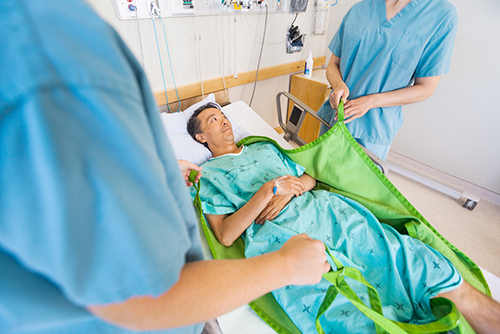The manual handling of patients: how to reduce the risk of musculoskeletal diseases.
 The manual handling of loads as regulated by the Law decree 81/2008 title VI is a type of activity that involves 30% of the workforce in Europe (according to the EWCS data from 2010). This activity is mostly carried out by men (40%), while the percentage of women who do this kind of job is just around 20%.
The manual handling of loads as regulated by the Law decree 81/2008 title VI is a type of activity that involves 30% of the workforce in Europe (according to the EWCS data from 2010). This activity is mostly carried out by men (40%), while the percentage of women who do this kind of job is just around 20%.
In fact men are mainly involved into heavy works especially in the building and manufacturing sector, while women are significantly involved when it comes to manually handling the patients (EWCS). INAIL, in its annual report for 2010 has highlighted how musculoskeletal diseases due to biomechanical overload are around 60% (26,000 cases) of the cases reported to the Institute in 2010. The cases which are most frequently reported (more than 9,000) are those related to intervertebral disc diseases that are essentially linked to all the manual handling of load activities.
The European Agency for Safety and Health at Work has published a series of reports over the last years which show the importance of all the problems related to the musculoskeletal diseases especially those affecting the spine and stemming from the manual handling of loads activities. Therefore the Agency has organized back in 2007 an informative campaign called 'Lighten the load' in order to promote a new integrated managing approach for work-related musculoskeletal diseases. If in any other activity the lifting concerns only the person who raises a load, when it comes to treatment and assistance it concerns also the recipient and no solution can be applied without taking into consideration the problems related to the human cargo. Supporting, lifting and transferring the patients are all high risk activities because all these activities can lead to back-lumbar injuries, or more generally musculoskeletal disorders according to the data from the Occupational Safety & Health Administration of the United States: these data showed that these kinds of activities led to 249 cases every 10,000 workers of absence from work in 2010, an average seven times higher than in all the other sectors.
In particular the link between physical effort and the subsequent diseases is more common when it comes to assist patients who cannot move or are not willing to collaborate.
When a person lifts, pushes or simply moves around another subject, forces which are normally felt will be produced and they will be balanced thanks to some automatic protection mechanisms of the systems involved.
However, when it is necessary to intervene very rapidly it could be necessary to increase the force level up to a point that even if it could be tolerated in a normal situation it cannot be tolerated when the biomechanical properties of the structures involved in the effort change (IPASVI). There are several activities that could be dangerous for health care assistants and there are several factors which play a role when it comes to take the right posture.
These factors are linked to the patient, who is a heavy and difficult load to move around and frequently forces the healthcare assistants to move rapidly, in difficult positions, making twists that prevent them from operating ergonomically. Furthermore, it is also important to pinpoint that the number of overweight or seriously obese patients is continuously growing.
The build of the patients makes it difficult to follow the specific procedure that needs to be followed to properly carry out those movements. Patients cannot be kept close to the body of the person who is moving them and frequently it is not possible to forecast what will happen during the movement.
In order to prevent these risks it is necessary to evaluate and choose the correct technique to be applied according to the characteristics of the patients (weight, his/her ability to cooperate during the movement, any medical condition which can affect the way the patient can be lifted and repositioned. The manual handling of the patient must be considered as a risky activity and therefore it should be kept to the strict necessary or even avoid it completely.
Anyway if it is necessary to handle a patient manually it is important to:
- make patients cooperate
- ask the other healthcare assistants for help;
- take the right posture, keeping your legs apart and slightly bent in order to move on a large bearing surface;
- avoid twisting or awkward positions;
- staying as close as possible to the patient before starting any type of movement;
- make sure the ways are clear and the floors are not slippery;
- verify that the work surface is at the right height so that your shoulders and knees can remain relaxed;
- move with the load close to your body, bend your knees and keep your back and neck relaxed and your back straight.
In order to reduce the overload stemming from the manual handling of the patient it is necessary to use equipment that help the health care assistants to move the patient as easily as possible without affecting the rachis of the health care assistant. This kind of equipment is generally made of: handy sheets, roller conveyors, rotary discs, ergonomic belts, harnesses.
Larger mechanical equipment such as transportable or ceiling lifters is very helpful but not always available.
In order to reduce the lifting activity a new model has recently been introduced in England. The new model is no longer focused on the operator but on the person in order to both overcome the limits that affect the independence of the patient and help the healthcare system to make patients more independent




